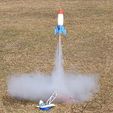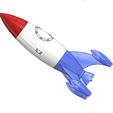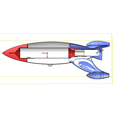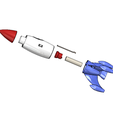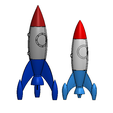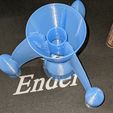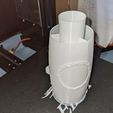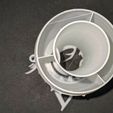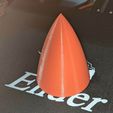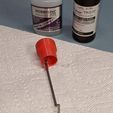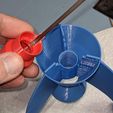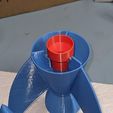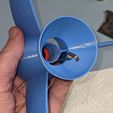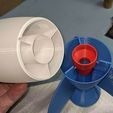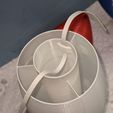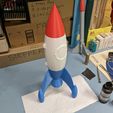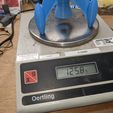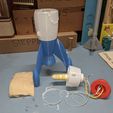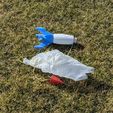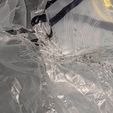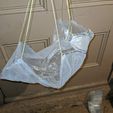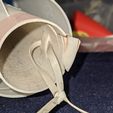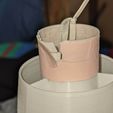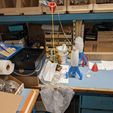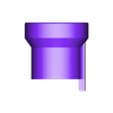03Apr update
I revised the top of the internal recovery tube to have a third concentric ring of 3D printed plastic for a length of 0.20 inches from the top. This should prevent the shock cord from pulling through the thin tube structure in the future.
11 Mar update
Yesterday, I made the first launch of the smaller, lighter-weight Space Rocket with a more powerful C5-3 engine. The sight of the powered flight phase into blue sky was fantastic. The chute was minimally heat-sealed from the ejection charge and failed to open completely during recovery. Surprisingly, the top of the extended recovery tube on the rocket airframe was cracked by the force of the shock cord snapping tight after the nosecone was jettisoned. I will be thickening up the top corner of the tube in the CAD model and I will post the stronger part to Cults3D in a day or two. You can see the video of the launch on YouTube at:
https://youtu.be/rwwAGF2s6vg
RocketFiles is on Facebook at:
https://www.facebook.com/RocketFiles-340621347252168
07 Mar update…
3D-printed Space Rocket, Rev II is assembled with a parachute and a C6-3 engine, but it is too windy to fly. It weighs in at 125.8 grams, 68.2 grams less than the first revision which maybe achieved 80-feet but coasted back to the ground prior to the recovery charge firing. I have read 117 and 113-grams as the maximum takeoff weight for a C6-3 engine, but I think based upon the previous almost 70-gram heavier rocket, this 10-gram excess now stands a good chance of working out. I have ordered three of the new C5-3 engines which will lift 227-grams so I may start there.
The four .STL files required to construct the rocket are now posted. I use cyanoacrylate adhesive to bond the printed PLA components and this seems to hold very securely. Other components required to make the rocket flight-ready are the engine clip, shock cord, screw eye for the nosecone, recovery wadding, parachute, and a C6-3 engine for a low flight or a C5-3 for more altitude.
3D printer configuration details...
- Test piece for thin wall printing setup.STL
Fill: not required on test piece
Wall thickness: set 2-lines, .8mm (slicer should only print 1)
Top and Bottom thickness: 2-layers, .4mm
Build plate adhesion not required
Support not required (print open side up)
May want to increase extruder flow to 103% and/or temperature to 215, for example, if single strands of each layer do not bond tightly to adjacent strands.
Coupling-Retainer 4.STL
Fill: 20-30% to keep weight down
Wall thickness: 2-lines, .8mm
Top and Bottom thickness: 2-layers, .4mm
Build plate adhesion: Brim, 10-lines
Support not required (print with clip holder up)
Airframe 4c.STL
Fill: 0% , not required anywhere
Wall thickness: 2-lines, .8mm (should only print 1 mostly except 2 for recovery tube which needs strength and heat resistance for ejection charge)
Top and Bottom thickness: 2-layers, .4mm (bottom of fin pods)
Build plate adhesion: Brim, 10-lines
Support: No (this part has no significant overhangs)
Fin Can 4c .031 fins.STL
Fill: 0% to make fins hollow
Wall thickness: 2-lines, .8mm (should only print 1 except at leading and trailing edges of fins)
Top and Bottom thickness: 2-layers, .4mm (bottom of fin pods)
Build plate adhesion: Brim, 10-lines
Support: Yes, greater than 85-degrees, touching build plate (rocket nozzle needs support, fins and other overhangs do not)
Nosecone 4c.STL
Fill: 63% fill to give 42-gram part weight for required aerodynamics
Wall thickness: 2-lines, .8mm
Top and Bottom thickness: 4-layers, .8mm
Build plate adhesion not required
Support not required
Good luck! Back to work!
04Mar update -
I now appreciate that the spectacular crash and "explosion" of the original Space Rocket was due to the rocket weighing 70 grams more than the engine's maximum rocket weight specification of 113 grams. The thrust curve suggested the engine force would be three or four times the weight of my heavy rocket so I thought I might have a chance without just giving up on revision #1 and starting immediately on a lighter revision #2. I was hoping that Estes was just being conservative. Wrong! Swing test and crash video links are below. New photo from my workbench shows the pieces...
So I have now finished the CAD design on revision #2 and just finished printing the fin can. It weighs only 21 grams, less than half the weight of its predecessor!
I dragged the rev 1 model into the CAD workspace for the rev 2 design and the screenshot of the two side by side gives you an idea of how much I shrunk the model, intending to keep the launch weight in the low 100's of grams.
I also discovered there is a new Estes engine part, C5-3, which has a maximum launch weight of 227 grams! I immediately ordered some of those from the factory just to be safe from potentially under-powering this new model. I'll decide if the original C6-3 will be adequate for rev 2 at a later date. It's nice to have the parachute deploy at an altitude where you can see what's happening!
I've posted the .STL for the fin can that I just took off the printer. I'll put up the other ones as I get successful print results. Probably will have them all up before Monday. Back to work!
The revision #1 story....
22Feb update - printed fin can (bottom) part of Space Rocket model and took photos of the process and the result. Printed with 0% infill and fins and fin pods are hollow. All walls are .8mm thick (two .4mm lines). Seeking to make the print as light as possible but the finished part weighs 71 grams with an engine installed. This is half the weight budget for a C8-3 engine and I've still got the airframe, a 100% filled nosecone for flight stability, and the recovery components left to go! I may be forced to reprint the fin can with .4mm wall thicknesses. I think I'm going to try the thin-wall print on the airframe which is up next. That will be interesting... back to work!
23Feb update... finished the airframe design (see CAD screenshots) and saved out as a .STL. Loaded to Cura and the slicer reported almost an 8 hour print job, but only 46 grams in weight. The single-line wall will be the way to go going forward if the PLA is bonded layer-to-layer well enough so as not to delaminate through normal wear and tear. If I could cut the fin-can weight by 30 or 40-grams, a reprint there might be worth it. So print job is started.. will be done tonight.. pic attached of first layers.
26Feb update... so the airframe was a bear to print because I kept getting very rough finishes.... aborted the print 4 times. then discovered through forums that artifacts I was seeing was due to high temperature. 210 had always been fine but this is the first time I had ever tried to print something with a single thickness wall only .4mm thick. I dropped the temperature to 205 and got a perfect result. I then printed the nosecone with an 85% fill to make the aerodynamics work and the model is almost ready for cyanoacrylate assembly and installation of the recovery system. There could be a launch this weekend!!
Still need to make a few tweaks to the model before posting all the parts with a guarantee of fitting together with no fuss. I wouldn't download and print anything yet unless you just want the model for your desk.
Picture of complete assembly with engine installed but no recovery is coming in at 186 grams... way over budget for a C6-3 so may be respinning the fin can with .019 inch thick skins instead of current .031 skins. Would reduce the weight by 30 or 40 grams. CAD system shows center of mass with 85% fill on nosecone far enough towards the nosecone to make me believe the fins will have enough leverage to keep the rocket on course. Swing test will confirm before launch. Back to work!!
27Feb update... Getting close... installed engine clip with red adapter for directing ejection charge into larger tube which will contain parachute. Installed shock elastic between loop I printed in the top of the airframe tube and the screw eye I installed in the nosecone. Waiting on UPS for the parachute and the C6-3 engines.
Final 3D printable .STL files will be up next week. Need to fix a couple of things that required Dremelling during assembly.....
28Feb update... Well, videos at YouTube show the successful swing test and launch of the Space Rocket. Unfortunately, the overweight configuration prevented the recovery system from deploying before the rocket hit the ground.
Swing Test:: https://youtu.be/verXGEU9ADc
Launch and landing: https://youtu.be/G684c5tC1GA
The rocket was 70 grams over the published maximum spec. at launch and failed to achieve sufficient altitude for the parachute to deploy before hitting the ground and locking the white airframe to the red nosecone. In this configuration, when the recovery charge fired a fraction of a second later, it blew the airframe in two because the nosecone would not release.
I will be redesigning the fin can with single layer skins to cut it weight by 40% which will allow the nosecone to be reprinted with a much lower fill percentage, perhaps shedding another 20 grams off the total weight.
Back to work!!

/https://fbi.cults3d.com/uploaders/17100638/illustration-file/15f25ee2-deeb-4ef6-9897-4414728a9b37/Rocket4Launch.jpg)
